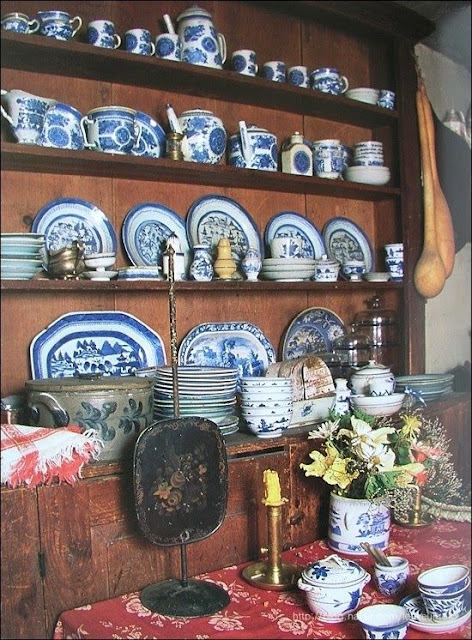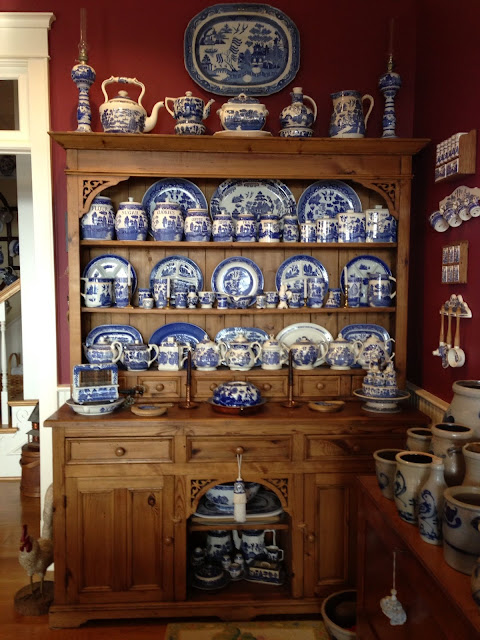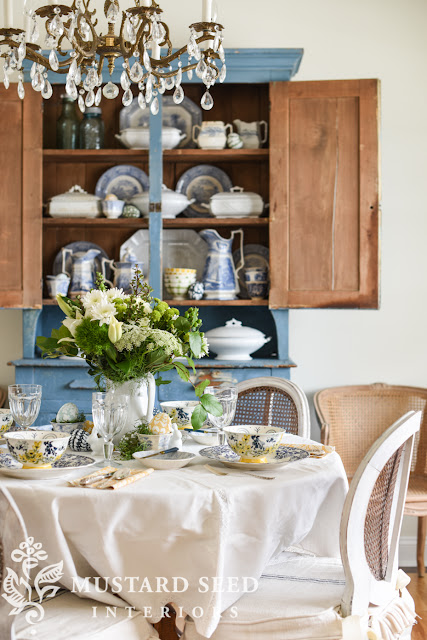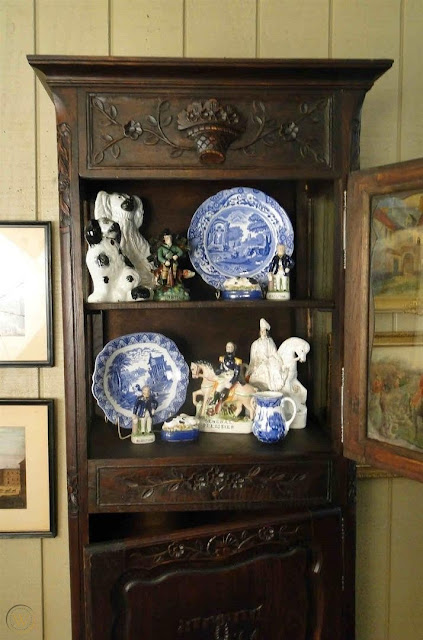During the 14th century the Chinese were the first responsible for the labor intensive process of painting porcelain in under-glaze blue. But it wasn’t until 300 years later in 1604 that a Dutch ship captured the Portuguese Catharina, who was returning from China loaded with 100,000 pieces of blue and white porcelains. The rest is history.
Over time blue and white transferware has become one of the beloved favorites of china collectors and a darling of interior designers everywhere.......a collectible that never really goes out of style.
These beautiful blue and white pieces are called transferware because of the more affordable process of transfer printing as a decorative technique that was developed in England in the mid-1750s, particularly in the Staffordshire region. Some of the earliest transferware patterns were done in blue and white with an Asian influence. "Chinese Blue" was popular in the mid-1700s. Before transfer printing was developed, each piece would be hand-decorated, which was difficult and expensive. This new process was invented in response to England's middle class consumer's longing for an affordable alternative to the hand-painted and expensive blue and white china of the aristocracy.
As they purchased these pieces the desire also came to display their treasures. The term cupboard was originally used to describe an open-shelved side table for displaying dishware more specifically plates, cups and saucers. These open cupboards typically had between one and three display tiers, and one or multiple drawers. The word cupboard gradually came to mean a closed piece of furniture
The purpose of this blog is to focus the spotlight on these beautiful cupboards full of lovely blue and white transfer collections. Antique or vintage transferware can add class and charm to your home décor, but a good display needs more that aesthetic appeal. You also need to protect your collection from potential damage.
Welsh cupboards and china cabinets are the ideal display vehicle for displaying your collections so that others can appreciate them as much as you do! Enjoy!!!
Blue and white transferware is definitely a perennial favorite of collectors. Besides the color, another reason for it's appeal is that it looks wonderful in display, especially in an antique wooden cupboard or cabinet. Before transfer printing was developed, many could not afford even a few pieces and certainly not a collection.
There are many subcategories to "blue transferware". Flo Blue, Blue Willow, and Staffordshire Historical Blue are all names of blue and white pieces decorated with underglaze transfer designs in cobalt blue.
At the turn of the 19th century Chinese patterns were very popular However, English companies began to incorporate European features. Staffordshire, or Historical Blue pieces feature important landmarks, scenes from history and commemorative events. Historical Blue was also a deeper darker blue.
via Pinterest
By 1812 English manufacturers were selling to the new American nation. The American market pieces featured important buildings, landscapes, war heroes and other patterns that appealed to Americans who loved the dark blue and white pieces.
via Pinterest
A huge amount of of this dark blue and white transferware was exported to the United States until about 1840-1860 when American factories began their own production.
Many gorgeous dark blue transfers were produced with floral, pastoral, and romantic themes as well.
As in this cupboard, strong visual impact can be created when you display a large group of blue and white transferware even if the shades vary. You can add in another color, just be careful....it needs to accentuate and not distract!!
via Pinterest
Around 1835-1875, Ironstone dark flow blue was at it's height of popularity. Isn't this collection beautifully displayed in a fabulous carved pine cupboard?
A central question when collecting blue and white transferware is how to display your treasures so that they will provide visual enjoyment for you and also your visitors.
No matter what kinds of objects capture your heart, if you collect them, you'll want to display them so they will be noticed. There is just something about open cupboards that enhance the blue and white transfer. I think it is because these pieces were used on a daily basis and don't bode well behind glass. I think they are much prettier presented openly.
Find a wonderful cupboard to house your collection first and then collect away!!
The casual appeal of blue and white transferwear assures that this classic is loved today just as much as it has been through the centuries.
Collecting these beautiful blue and white pieces is so addictive that those who collect antique transferware commonly refer to it as a "passion"!
You have to admit that a cupboard full of blue and white transferwear is endearing no matter the size!
A Welsh dresser (British, English) or a china hutch (American), and even sometimes called a pewter cupboard is a piece of wooden furniture introduced in the 18th century and consisting of drawers and cupboards in the lower part, an open upper section with shelves for storing plates, and perhaps a sideboard on top. This was an utilitarian piece of furniture used to store and display crockery, silverware, pewter, and china and makes one of the best transferware display cupboards. In fact it is my favorite!
Charles Faudree
Another transferware pattern called Blue Willow refers to a pattern based on a Chinese love story featuring lovers on a bridge and is charmingly displayed in this Welsh cupboard. Your collection should be grouped together in one or two areas so that it can be seen as a collection of similar items. This way you will get the maximum visual impact. See how that is done here in this room. Displaying your transferware randomly throughout the house only serves to dilute the eye appeal and make the whole collection seem disconnected.
Each piece of transferware pottery is a actually a miniature work of art. Whether a few pieces grouped together or a large cupboard full displayed en masse, blue and white transfer makes an exquisite decorative statement. It is hard not to collect these pieces.
WVJazzman on
Most transferware patterns sought by collectors today are two-tone in color: blue and white, red and white, and brown and white are the most common colors. It is hard to find the valuable English pieces made from the 1700s through the late 1800s offered for sale in antique shops at affordable prices.
You can find pieces made during the 20th century in most areas. While they’re not as valuable as the true antique versions, they can still be just as pretty. Here is a display of blue and white transferware in an old cupboard that achieves a rustic, country look.
via Pinterest
Whether you collect the most or the least expensive..... display blue transfer in an antique cupboard for a beautiful look.
If you are tired of some of your old furniture pieces refresh and refurbish them with paint. Blue and white transferware displays well in a number of colors.
Transferware and old chippy cabinets are also a good combination. It's always best to try and find one with natural distressing due to age.
This is a good shade of green to compliment blue and white dishes. Just remember that painting a beautiful antique just to stay on trend may not be a great idea.
Isn't the transferware striking against the red paint of the built-ins? My philosophy is paint and distress inexpensive old and vintage pieces or built ins.....but not antiques!
I think it is pretty how this lighter blue transferware is displayed in a soft muted blue cupboard that leaves the inside natural wood. Very warm and charming.
If you want a bit of color, paint the inside of your cupboard and leave the exterior natural. Blue and white transferware works well with green so it is an excellent choice.
via Pinterest
You can even make your cupboard more interesting if you decorate it with printed fabric or wallpaper. Just keep in mind that it shouldn’t distract from your blue transferware. Take your time and make a wise choice.
A lovely French Provincial style dining area. You can also use armoires to display your collection of blue and white dishes.
Andrew Maier
Transferware collections look amazing displayed in cupboards painted in shades of white. Again remember that painting good antique furniture will definitely effect their value in a guaranteed negative way.
Kathryn Greeley
via Pinterest
Aiken House & Garden
Blue and white always creates vintage charm in your décor.
This blue and white transfer collection helps to add instant farmhouse feel to this space.
White paint always gives an interior a fresh feel. Blue and white porcelain does the same thing so together you can't go wrong if you are looking for a fresh, crisp space.
There are many style of cupboards and cabinets that will enhance the beauty of your transferware collection. This antique French Black Forest bookcase and cabinet will demand attention wherever it is placed.
via Pinterest
The objects in your display do not need to all match. You can add other pieces in with your blue and white transferware. Just make sure the colors work well together. Staffordshire figurines are the perfect compliment!!
No matter how small your treasured collection is there will be a cabinet just perfect for it. Here it happens to be a painted French estagnier.
Photo: @antoniomonfreda
Don't sell attractive build in cupboards short as they too can be stunning ways to display your blue and white transferware.
via Victoria Magazine
You needn't limit a display of transferware to plates alone. Combine them with other transfer pieces as well as non transferware that works well in a display.
I know this post is about blue and white transferware but I had to touch on another type of collectible blue and white tin glazed earthenware that is also quite stunning en mass in a beautiful antique cupboard. Delft Blue is the world-famous pottery that is a a form of faience and has been produced in the city of Delft in the Netherlands since the 17th century.
Blue and white Delft Holland pieces in bright yellow cupboards at Maison de Claude Monet, Giverny.
via Pinterest
No matter what style of transferware you collect, a well-decorated china cupboard can be a beautiful addition to any room. Make your cupboard the highlight of your dining room by decorating it to it's best effect.
Your cupboards of blue and white transferwear may never rival the collection of John Rosselli.......
but keep trying!
FYI
If you are interested in collecting transferware, understanding some basic differences between old and new will help. I am no expert but have found a few tips for the collector.
2. Most new marks average 2 to 3 inches across no matter the size of the piece. Most marks on authentic blue transfer are rarely over 1 inch in size.
3. Look for a pattern name sometimes printed on the back. Then do some on-line research. There are data bases that will identify the date and who made the various patterns.
4. Look for uneven application and glaze. Early transfer pieces will have uneven gaps, creases, and seams that don't match in the printed patterns. Also you will have glaze drips or gaps in the glazing over the pattern.
5. "Made in" indicates modern manufacturer.
6. Authentic pieces will feel lighter. Later, mass produced plates were usually heavier.
The best value for transferware is in old, Victorian examples. Early Asian influenced designs and items featuring images of American historic views from 1820–1840 are in high demand and expensive. Though Flow Blue is popular and can be quite valuable, so much was produced that there is a lot of it out there. Flow Blue was highly reproduced in the late 20th century.
Click here to see the previous post
This blog post was published by Lisa Farmer
In the event that I have not credited the correct source of an image, please contact me at lisafarmerdesigns46@yahoo.com and I would be glad to correct it.





















































